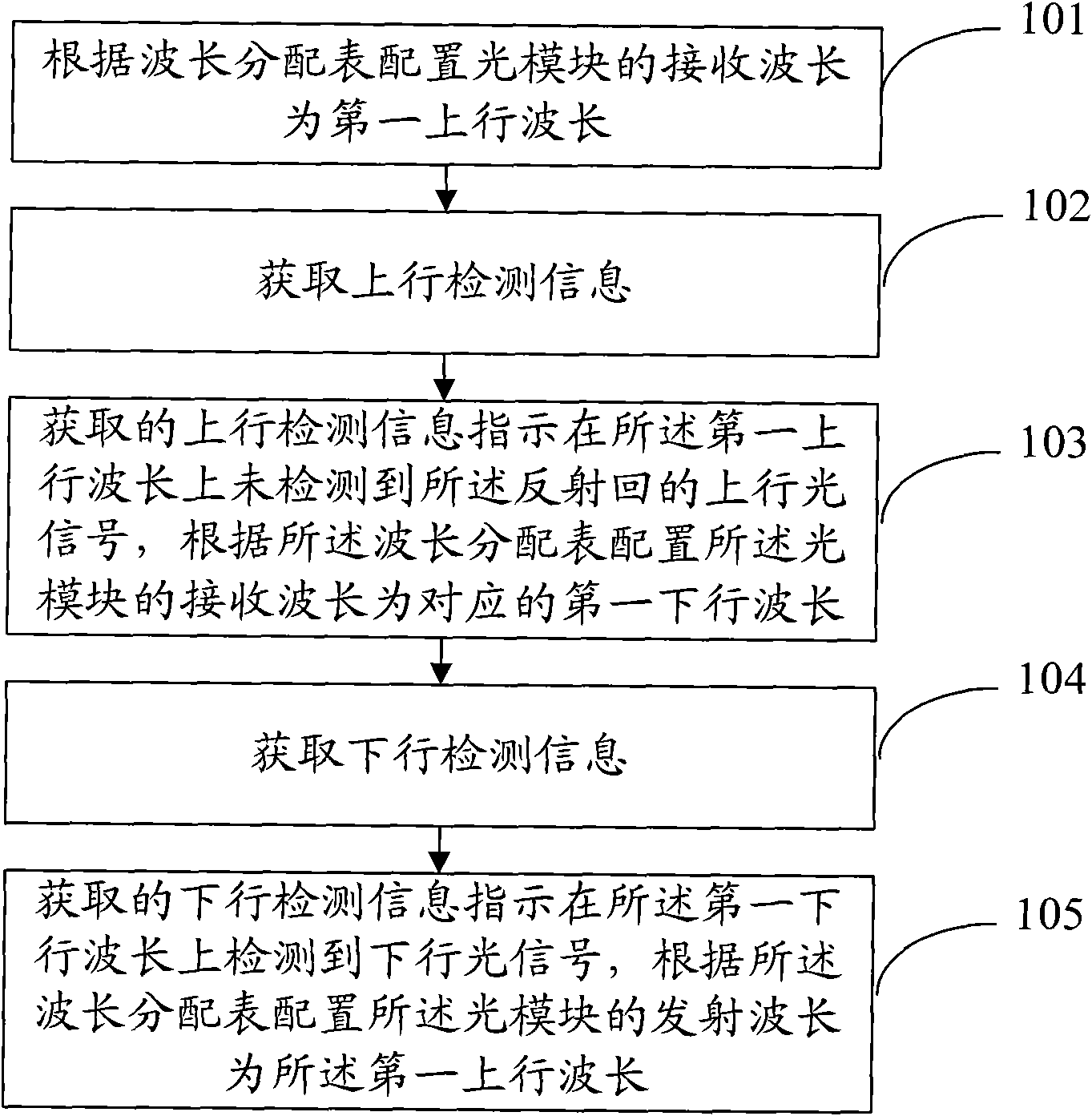Wavelength selection method, device and system
A wavelength selection and wavelength technology, applied in the field of optical communication, can solve the problems of difficulty in implementation and popularization, large equipment changes, etc., and achieve the effect of simple implementation, small modification, and convenient implementation and popularization.
- Summary
- Abstract
- Description
- Claims
- Application Information
AI Technical Summary
Problems solved by technology
Method used
Image
Examples
Embodiment 1
[0045] This embodiment provides a method for selecting a wavelength. Before the method is implemented, a partial mirror can be installed on the remote node (Remote Node, RN) of the ODN to reflect the uplink optical signal during transmission back to the RE. . This method can be deployed on the optical module or on the RE. Such as figure 2 As shown, the method includes:
[0046] Step 101, configure the receiving wavelength of the optical module as the first uplink wavelength according to the wavelength allocation table;
[0047] Step 102, acquiring uplink detection information, the uplink detection information is used to indicate whether an uplink optical signal reflected back by a part of the mirror is detected on the first uplink wavelength;
[0048] Step 103, if the acquired uplink detection information indicates that the reflected uplink optical signal is not detected on the first uplink wavelength, configure the receiving wavelength of the optical module to be the corr...
Embodiment 2
[0055] This embodiment specifically provides a wavelength selection method. Before the method is implemented, a partial mirror can be installed on the RN of the ODN to reflect the uplink optical signal during transmission back to the RE. The system architecture after installing the partial reflector can be as follows image 3 shown. Among them, REC and RE are specifically image 3 Similarly, the corresponding BBU and RRU use a pair of uplink and downlink wavelengths to transmit their uplink optical signals and downlink optical signals. For example, the downlink CPRI optical signal can be transmitted between BBU1 and RRU1 through λd1, and the uplink CRPI optical signal can be transmitted through λu1.
[0056] In fact, there are also optical modules in the BBU, but because the method in this embodiment does not need to change the BBU, so in image 3 not shown in. Because the method provided in this embodiment is applicable to be deployed on a dimmable light module, so imag...
Embodiment 3
[0089] This embodiment specifically provides a wavelength selection method. Before the method is implemented, a partial reflector may also be installed on the RN of the ODN to reflect the uplink optical signal during transmission back to the RE. The schematic diagram of part of the system construction after installing the partial reflector can also refer to image 3 . The main difference between embodiment 3 and embodiment 1 is that the method for selecting the wavelength provided is implemented inside the RRU. Both the transmit and receive wavelengths of the tunable transmitter and tunable receiver in the tunable optical module in this implementation can be adjusted, and the RRU can set the transceiver wavelength of the tunable optical module through a wavelength setting (WL_SET) signal.
[0090] For the workflow of BBU1 in this embodiment, refer to the workflow of BBU1 in Embodiment 2.
[0091] The following describes the workflow of RRU1 corresponding to BBU1 in this embo...
PUM
 Login to View More
Login to View More Abstract
Description
Claims
Application Information
 Login to View More
Login to View More - R&D
- Intellectual Property
- Life Sciences
- Materials
- Tech Scout
- Unparalleled Data Quality
- Higher Quality Content
- 60% Fewer Hallucinations
Browse by: Latest US Patents, China's latest patents, Technical Efficacy Thesaurus, Application Domain, Technology Topic, Popular Technical Reports.
© 2025 PatSnap. All rights reserved.Legal|Privacy policy|Modern Slavery Act Transparency Statement|Sitemap|About US| Contact US: help@patsnap.com



